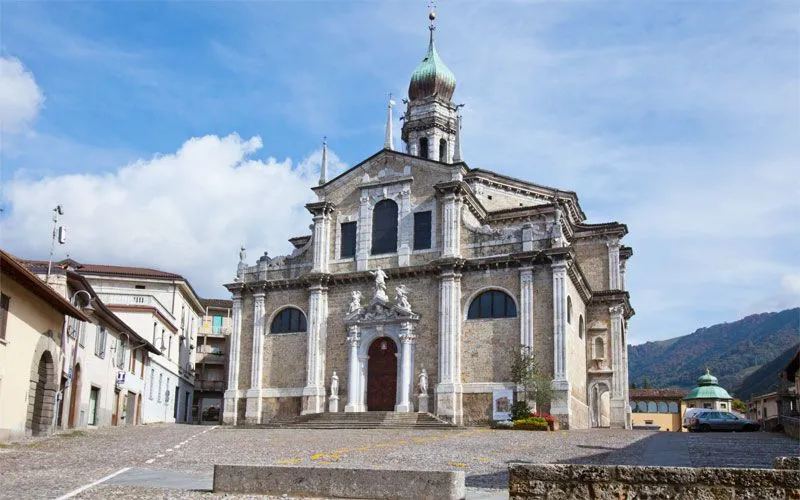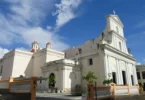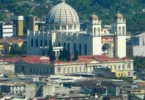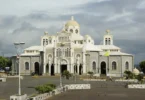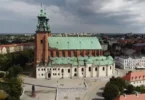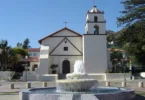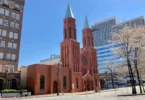Introduction
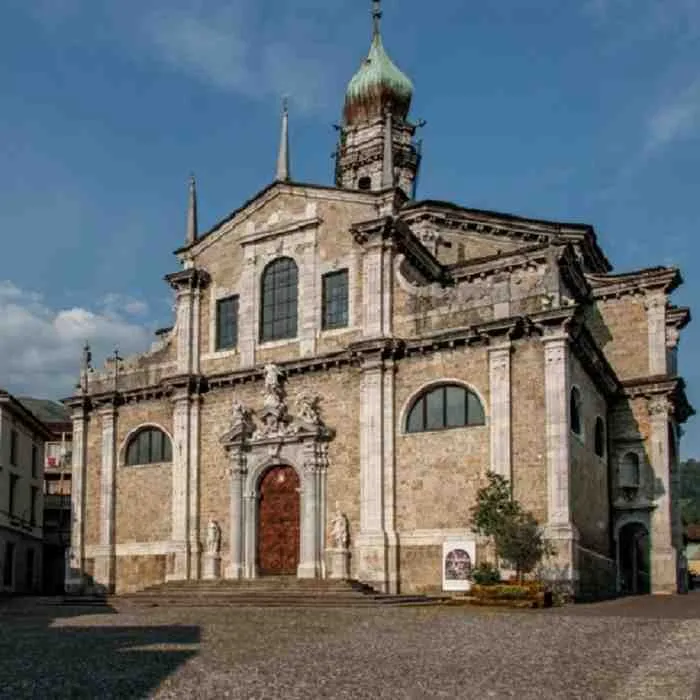
The Basilica of Santa Maria Assunta is the principal Catholic place of worship in Gandino, located in the province and diocese of Bergamo, within the local vicariate of Gandino. It is a provost church and was granted the title of minor basilica on May 17, 1911, by Pope Pius X.
Situated in Piazza Emancipazione, at the heart of the town’s historic center, the basilica has always held great significance for the local community. This is evident in the many donations received over the centuries, which have enabled the church to acquire numerous important works of art. Recognized for its historical and artistic value, the basilica blends elements from various architectural traditions, including Venetian, Central European, and Lombard styles. One notable feature is the onion dome of the bell tower, a distinct characteristic of the Central European influence.
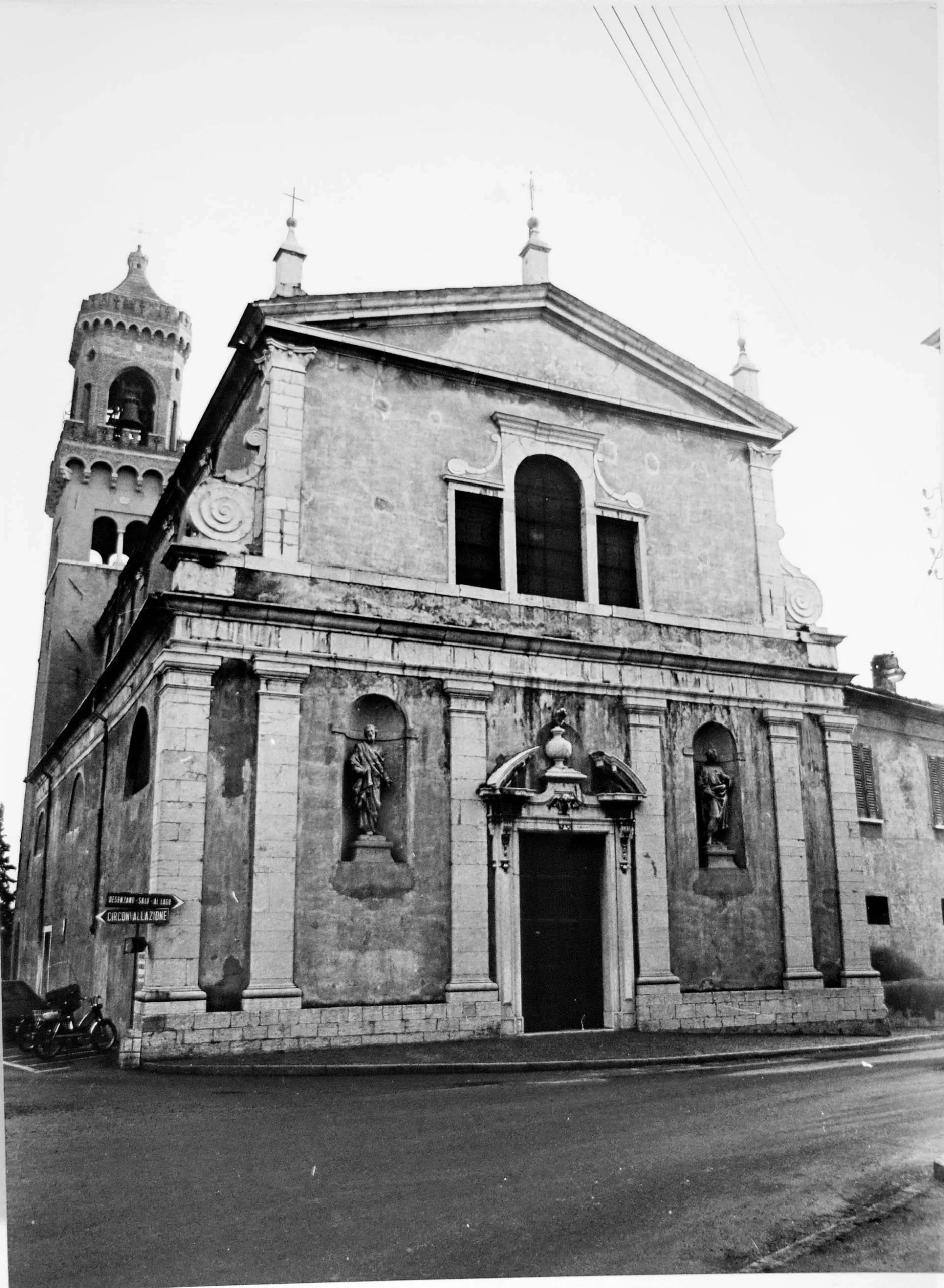
The first references to the Basilica of Santa Maria Assunta appear in documents from May 3, 1180, when Bishop Guala of Bergamo mentioned the church as Clerici Ecclesiae Sanctae Mariae di loco Gandino. Additionally, testamentary deeds from August 5, 1181, written by the notary Aragotti, further confirm its existence. In 1233, the basilica was cited in documents that marked the municipal emancipation of the town, highlighting its established importance at that time. Although the exact dimensions of the original structure are unknown, it is believed to have included a bell tower and a portico. This assumption is supported by a deed from July 6, 1233, which notes that the inhabitants of Gandino signed the document “under the portico of Santa Maria,” suggesting the presence of such a feature.
The Fifteenth Century
To accommodate the growing population, the original structure of the church was replaced by a larger building in 1421, which was completed by 1423 and consecrated by Bishop Francesco Aregazzi on August 16, 1430. In 1469, the church was further expanded with the addition of a second nave to the south. However, the interior must have been asymmetrical, as noted in the 1575 pastoral visit by Saint Charles Borromeo. A 1609 report by Giovanni Giglio from Ravenna, consulted by the church warden Alessandro Castelli, described the church as large, “satis capax et ampla,” with a traditional liturgical layout that included an apse to the east. The main chapel, built in 1575, was separated from the main hall by an iron gate. The church housed nine altars inside and two outside. The report also mentioned the presence of three porched openings on three sides of the church.
The bell tower was positioned on the left side of the apse, and there were two sacristies of varying sizes. A 1445 document confirmed that the main altar was complete with a crypt. The counter-facade of the church featured frescoes that were rediscovered during the 1992 restoration. Many of the ancient furnishings were later moved to the basilica museum. Initially, the church depended on the parish of Nembro. As was customary, its priests would travel to collect the Holy Oils on Holy Saturday from the parish church. However, after forty years of this practice being moved to the cathedral in Bergamo, the archpriest of Nembro, Giovanni dalla Costa, reached an agreement on March 26, 1425, with the clergy and local community, allowing the Gandino parish to collect the Chrism directly from Bergamo, though only for the parish’s residents. In 1459, the church was granted provostral status by Pope Pius II, elevating it from its previous affiliation with the parish of San Martino di Nembro and giving it jurisdiction over the neighboring parishes. The church became a key religious and cultural institution in the Gandino area.
The Seventeenth Century
As the number of believers continued to grow, it became clear that a significant structural expansion was necessary. In the early years of the seventeenth century, the need for a more substantial change to the church was recognized. In 1603, Curate Giovanni Battista Rizzi brought the issue to the attention of the municipal council. Since 1575, following a diocesan visit by Saint Charles Borromeo, the church had been subject to a series of small alterations to meet the guidelines of the Council of Trent, but these modifications were insufficient to properly accommodate the increasing congregation. To mark the beginning of the work, a plaque was walled up on the south side of the building. The project was entrusted to Paolo Micheli from Gandino, who preserved the north and west walls of the existing structure while adding a third nave. On August 14, 1623, the first stone was blessed, officially commencing the expansion. The project required financial support from all the citizens, reflecting the communal effort involved in the church’s redevelopment.
The construction work began in 1623 with a comprehensive plan for the church’s reconstruction. However, progress was significantly slowed by the 1630 plague outbreak, which also claimed the life of the designer. The epidemic was first documented on June 28, 1630, when the construction was already well underway, allowing it to serve as a burial site for prominent families in Gandino. However, the unpleasant odor from these burials led to the closure of the church, and the Blessed Sacrament and relics of the patron saints were moved to the nearby Church of Santa Croce. The situation was eventually overcome, as a 1631 document describes a procession from the Church of Santa Croce back to the Marian church, during which the ancient tabernacle was restored to its original place. The church’s construction was completed with the addition of a large dome, designed by Giovan Maria Bettera in 1640, with contributions from several architects and skilled craftsmen. Some assets were sold to fund the project, while others were preserved, including the Corinthian bronze balustrades, created in 1590 by Francesco Lagostino at the request of the Giovanelli brothers.
The basilica was dedicated to Santa Maria Assunta and consecrated on September 13, 1654 by Carlo Nembrini, the bishop of Parma, who was originally from Gandino. However, the church was not yet fully finished, as the eleven side altars and their decorations were added later. In 1733, the original flooring was replaced with octagonal black marble slabs, with portions in white marble. In 1911, the church was elevated to the status of a minor basilica by Pope Pius X. In 1932, the high altar was removed to make way for the construction of a new crypt.
Architecture of Basilica of Santa Maria Assunta, Gandino, Italy
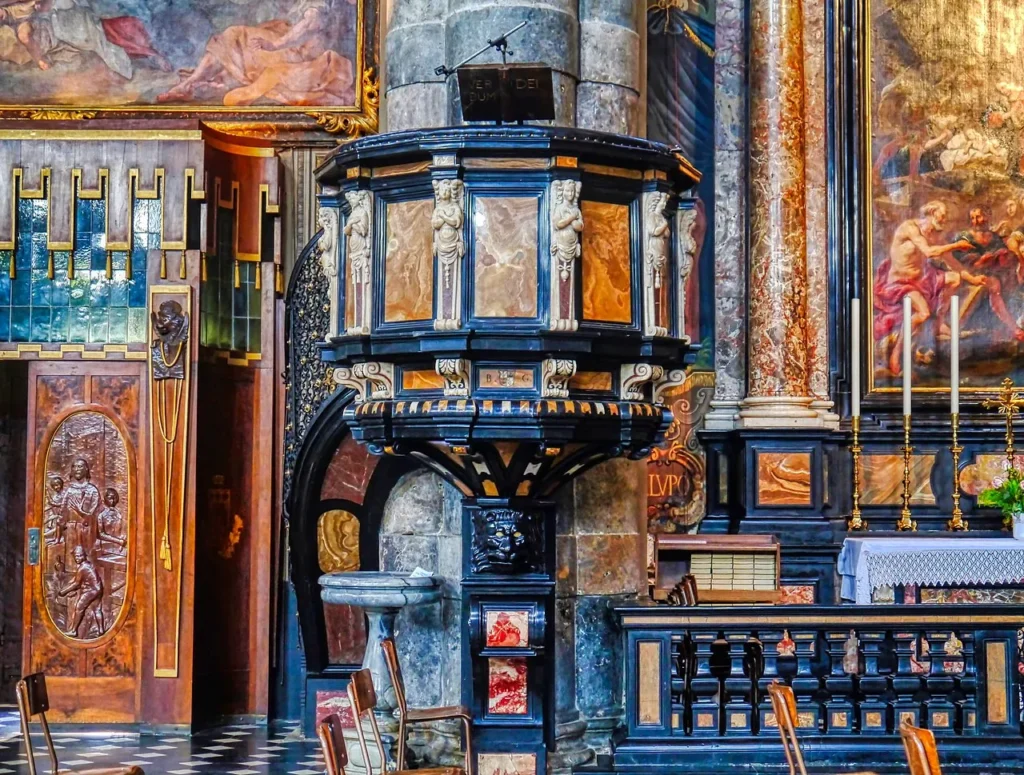
Exterior of the Basilica
The church is framed by a large sloping square leading up to the steps, which enhances the prominence of the pediment. The structure has remained largely unchanged over time, featuring a roof composed of a series of slopes at varying heights, known as a salient façade. Constructed from local stone with warm tones, the façade highlights the pilasters and cornices, which are accentuated with lighter shades. The two-tiered façade, visible in its entirety from the end of the expansive square, includes portals crafted by Venetian artists Domenico Rossi and Antonio Cavalleri, while the zoomorphic statues were sculpted in Rovinj stone by Paolo Callolo and Paolo Groppelli in 1712.
The complexity of the building is also evident from the side, where the church stands isolated from the surrounding structures, enhancing its distinct architectural presence. The central portal, funded by Girolamo Castello, was designed by Domenico Rossi and executed by Antonio Cavallieri in 1712 at his Venetian workshop. The portal was transported via river to Palazzolo and then by cart to Gandino. Above the broken tympanum, statues of two angels flank a central figure of the Madonna Assunta, all created by Paolo Callolo. The statues of Saints Quirino and Flaviano, created in 1740, adorn the arch, with an inscription reading: “BASILICA S. MARIAE ASSUMPTAE EX DECR. MCMXI PII X PM.” The upper section contains another inscription: “EQUES HIERONIMUS CASTELLI – PORTAM HANC CONSTRUI LEGAVIT ANNO – MDCCXII.”
Bell Tower
Dominating the structure is the hexagonal bell tower, which reaches a height of 77 meters. Completed in 1657, it stands as the tallest bell tower in the Gandino valley. The tower is crowned by an onion dome of Central European style, equipped with a 13-meter copper spire. The dome was built by Giovanni Bettera, nephew of the architect who designed the interior dome, and was covered with copper by Francesco Shgraffer from Bolzano and Paolo Sterzl from Trentino, later gilded in 1677.
The bell tower houses a set of 10 bells, tuned to the note B and dating from 1786 to 1822, crafted by Giacomo Crespi. These bells were preserved from requisition during World War II thanks to the efforts of Father Giovanni Marconi, the parish priest at the time. Atop the bell tower’s spire, a cross bears the inscription: “Christ defend this Gandino village from all evil.”
Interior of the Basilica
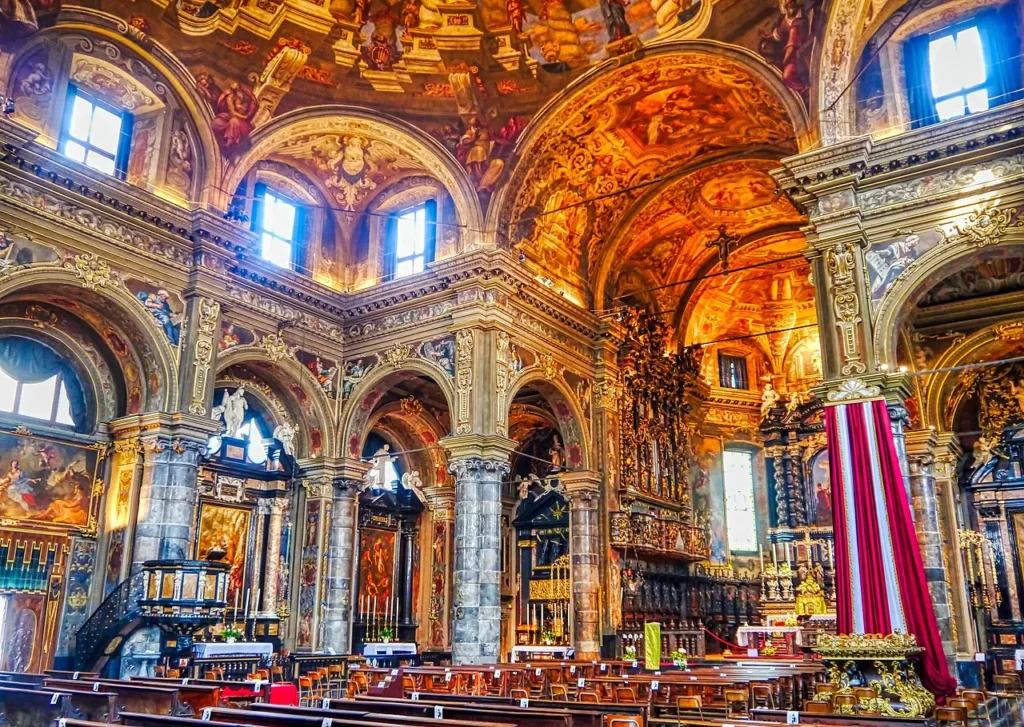
The basilica features a single-nave hall with a square plan, which opens like a vast transept. Four large, polylobed pillars support the imposing dome, constructed in 1640 by Giovan Battista Bettera, with a design by Antonio Comino from Brescia. The church is accessed through wooden doors, the largest of which dates back to 1831. These doors, designed by Alessandro Finazzi and crafted by Giuseppe Licini from Bergamo, were made in via Borgo Canale. The doors are adorned with depictions of the city’s patron saints: Pontian, Valentine, Quirinus, and Flavian. The lateral doors feature images of Saint John the Baptist, Saint Anthony of Padua, Saint Gaetano of Thiene, and Saint Anthony the Abbot, along with figures of the apostles and a central depiction of the Assumption of Mary. The lateral entrance doors were installed in 1962, created by Angelo Gritti and featuring bas-reliefs of the evangelists’ symbols.
The expansive nave is lined with eleven altars and four corner chapels. It culminates in the large presbytery, bordered by a bronze balustrade and covered by a barrel vault decorated by Ottaviano Viviani. The ancient tapestries, donated by the Castello family and depicting the Life of the Virgin Mary, date back to 1580 and were made by Cornelio and Enrico Mattens in Brussels. These tapestries were removed during the seventeenth-century renovation and are now housed in the basilica museum. The altars within the church follow a consistent architectural style, indicating that, although construction occurred over time, the architects maintained a unified design approach. The side chapels, too, share this style, with the notable exception of the altar dedicated to the patron saints.
At a height of 12.5 meters, the cornice features 28 canvases painted by Giacomo Ceruti, depicting prophets and figures from the Old Testament. Each figure holds a scroll that identifies them, including Joshua, Zechariah, Nahum, Malachi, Isaiah, Solomon, Job, Daniel, and others. These works were not painted simultaneously—those near the entrances are dated 1724 and follow a late eighteenth-century style, while the remaining canvases, dating from 1737, reflect the influence of Tiepolo and Sebastiano Ricci, whom Ceruti encountered during his time in Venice. The basilica also houses twelve other works by Ceruti, making it home to one of his most complete artistic cycles.
On the counter-facade, there’s a striking canvas by Paolo Zimengoli from 1718, depicting the “Universal Flood”, which replaced an earlier fresco of the same subject by Jachominus of Crema from the 15th century. The counter-facade is completed by a large, round-arched glass window, a German-made piece designed by Virginio Muzio in 1898.
The back wall of the basilica also features four confessionals, two of which are sculptural works by Andrea Fantoni, designed by Giovan Battista Caniana between 1721 and 1724. These confessionals were made for the parish priest and the city vicar.
Chapels and Altars
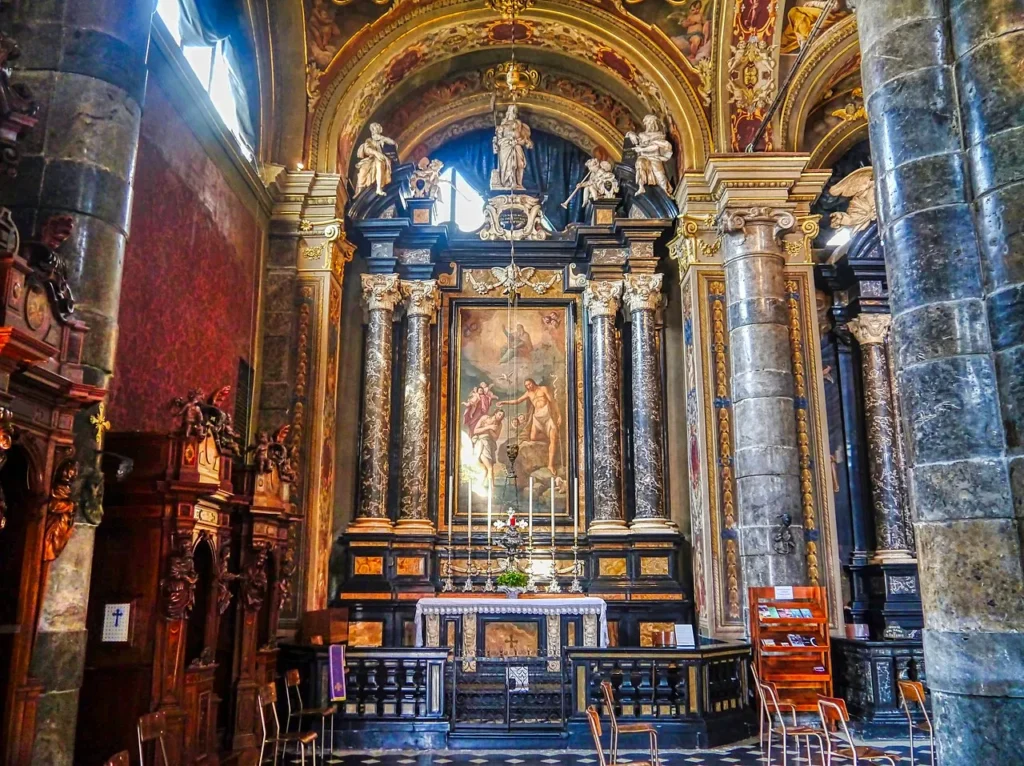
Over time, various schools, congregations, and numerous donors have contributed to the construction and expansion of the church’s altars and chapels. Starting from the left, they are as follows:
Altar of Saint John the Baptist
The first altar on the left is dedicated to Saint John the Baptist. Built in 1661 under the commission of Giovan Battista Giovanelli, son of Gualtiero, the altar features four columns made of oculus marble, framed by alabaster mirrors and friezes crafted from Carrara marble, lending it a majestic appearance. The altarpiece, titled “Baptism of Jesus in the Waters of the Jordan”, is a work by Francesco della Madonna from Gandino. On the pediment, statues by Flemish artist Arrigo Merengo from the mid-17th century depict the saint at the center, with prophets Isaiah and Jeremiah on either side. Two musical angels herald the arrival of John as a messenger. The chapel’s vault is adorned with a fresco by Giacomo Ceruti, titled “Decollation”, later repainted by Ponziano Loverini from Gandino. The chapel was originally dedicated to the sacrament of baptism, and the original font, crafted by Battista de Mendossi in 1565, is preserved in the octagonal baptistery near the basilica.
Altar of Saint Anthony of Padua
The second altar is dedicated to Saint Anthony of Padua, a saint held in great reverence by the people of Gandino. The altar’s completion and commissioning are unknown, but it includes statues of the saint and two angels placed on the gable. The altarpiece, “Vision of the Child Jesus”, painted by Giovanni Manfredini around 1790, portrays a scene from the saint’s life in a style reflecting the iconography of the Counter-Reformation. The side frescoes depict two female figures: one with a book and a torch, the other with a cross and a skull, symbolizing humanity’s salvation. Additionally, the altar features a 1715 canvas by Antonio Balestra, “Rest from the Flight into Egypt”, which portrays the Holy Family with dramatic intensity, with the Madonna and Saint Joseph flanking the Christ Child.
The large octagonal pulpit from 1657 rests on a pillar next to this altar. It is divided into sections made of Gandino alabaster and features pilasters with white marble caryatids. The pulpit was commissioned by Benedetto Giovanelli and adorned with a fabric canopy, which was removed in 1978 and is now kept in the basilica museum.
Altar of the Nativity and Saint Alexander
Built in 1659, the altar of the Nativity and Saint Alexander features the coat of arms of Bartolomeo and Alessandro Savi, who commissioned it. The altarpiece depicts the Nativity of Jesus, with Saint Gerolamo, Saint Alexander of Bergamo, and angels, painted by Gian Cristoforo Storer. The altar includes a pediment with statues of Saint Alexander of Bergamo and two angels, sculpted by Giuseppe Siccardi in 1932. A nearby painting of Saint Grata of Bergamo connects to the story of Saint Alexander, showing the flowers born from his martyrdom and his father Saint Lupo.
Altar of the Dead
The fourth altar is dedicated to the cult of suffrage, a theme prominent after the 1630 plague that decimated Gandino’s population. Built in 1672 by the Misericordia consortium, it is made of black marble from Gazzaniga, with statues of Saint Francis of Assisi and angels by Giuseppe Siccardi (1932). The altar’s altarpiece, titled “Pietà and Purgatory” by Luca Sanza di Pasau from 1699, depicts the Virgin Mary holding the dead Christ, while souls in the flames of hell ask for salvation. Saint Julian is also depicted, and the chapel includes another work by Giacomo Ceruti, “Apparition of the Risen Christ to Mary Magdalene” (1734).
Altar of the Patron Saints
This altar, dedicated to Saints Pontian, Valentine, Quirinus, and Flavian, has a distinct structure and was more expensive to build than the others. It was commissioned by Francesco Nembrini to house his tomb. The altar is flanked by black fluted pilasters crowned by Ionic capitals and is topped with a black gilded tympanum featuring three golden palms, symbolizing martyrdom. The central copper sarcophagus with statues of the three saints was created by Giovanni Schmidel of Nuremberg in 1646, and the gilding was added by Pietro Ceredi. The altar features works by various artists, including three large canvases by Giacomo Ceruti: “Saint Pontian in Glory”, “Saint Quirinus”, and “Saint Valentine”. Francesco della Madonna painted the lateral canvases: “Saint Justus” and “Saint Abbondio in Contemplation”.
Altar of Saint Peter
The altar dedicated to Saint Peter was part of the original 15th-century church. The statue of the saint, created by Pietro Bussolo, is now in the basilica museum. The altar’s design mirrors that of the Patron Saints’ altar, created by Andrea Manni. The altarpiece, painted by Gian Giacomo Barbelli in 1647, shows Christ delivering the keys to Saint Peter. The pediment contains a fresco by Giacomo Ceruti (1734) depicting Saint Peter with the inscription: “You are Peter, and on this rock I will build my church”. Ceruti also painted “Saint Peter Saddened by the Cockcrow” and “Saint Peter Freed from Chains”. Statues of angels and Saint Peter by Giuseppe Siccardi adorn the pediment.
Altar of the Blessed Sacrament
Originally meant to be the burial site for the Giovanelli family, this altar is made of black Belgian marble. The altarpiece, painted by Simone Cantarini around 1647, depicts the Coronation of the Virgin. It shows the family’s patron saints, Saint Vincent the Levite and Saint Benedict, at the bottom, while the Virgin is surrounded by angels. Above her, Jesus and God the Father hold a tiara with a dove representing the Holy Spirit. The pediment features statues of Faith, Hope, and Charity.
Altar of the Sacred Heart
This altar was originally dedicated to the Most Holy Name of Jesus and was built at the request of Serafino Bertocchi and Giovan Maria Giovanelli. It once housed a canvas by Pietro Mango, “The Circumcision of Jesus” (1655), now replaced by Pietro Servalli’s painting “The Last Supper”, which emphasizes Christ’s love for humanity. The altar’s pediment, by Giuseppe Siccardi, features two angels and a depiction of the Sacred Heart.
Altar of Our Lady of the Rosary
This altar, erected in 1640 by Gian Andrea Manni, was commissioned by Giovanni Marco Marinelli and the Brotherhood of the Holy Rosary. It is built with two Corinthian columns supporting a pediment adorned with statues of Our Lady of the Rosary and two angels. The altarpiece, painted by Domenico Carpinoni, depicts Saint Dominic adoring the Madonna. On the sides are frescoes of Saint Rosa and Saint Dominic. The Brotherhood of the Holy Rosary originally provided silver furnishings and lamps for the altar, though they were requisitioned during the Napoleonic occupation.
Altar of Our Lady of the Belt
Built in 1657, this altar is constructed with six Ionic columns supporting a semicircular broken tympanum. The fresco on the vault, “Judith with the Head of Holofernes”, was painted by Giacomo Ceruti in 1734 and later repainted by Ponziano Loverini. The altar’s decorations include “Via Crucis” sculptures by Giuseppe Siccardi and frescoes by Alberto Marinoni and Giuseppe Rota from 1897. The inscription on the cymatium reads: “If you ask who built the altar, it is not important to know, because we are only men.”
Presbytery
The presbytery, elevated by steps made of black marble from Gazzaniga, is enclosed by a Corinthian bronze balustrade dating back to 1590. This work, crafted by Francesco Lagostino, was commissioned by brothers Nicola, Andrea, and Silvestro Giovanelli, as noted in the inscription: “In honor of the Most Holy Mother of God for the innumerable and greatest gifts made to them.” The Renaissance-style balustrade features groups of three small pillars that support a trabeation, with ornamental vases placed atop.
The high altar, consecrated on September 13, 1654, by Carlo Nembrini, Bishop of Parma and native of Gandino, is crafted from polychrome marble. It is adorned with six 17th-century bronze candelabra, while the crucifix, Madonna with St. John, and the bronze antependium are works by Renato Bonizzi and Giuseppe Siccardi, respectively. The altar consists of four large columns, crowned by Corinthian capitals in occhialino marble, the work of the Fantoni family from Rovetta. It holds the painting Maria Assunta with the Patron Saints, created by Ponziano Loverini in 1924. The pediment features five statues, likely by Andrea Fantoni, in bleached wood, depicting the Madonna Assunta in the center, holding the book of seven seals, flanked by two angels and two female figures.
The presbytery is illuminated by two large stained glass windows, made in Germany and designed by Virginio Muzio in 1898. On either side, two large canvases by Giacomo Ceruti depict The Birth of the Virgin and The Death of Mary. At the back of the presbytery stands a wooden choir by Ignazio Hillepront, which consists of 25 stalls, each decorated with acanthus leaf motifs. The central back panels feature bas-reliefs illustrating the stories of the Virgin. The stalls are divided by scrolled armrests and pilaster strips adorned with acanthus leaves and cherubs. Although the choir was built in the 17th century, it was completed in 1718.
The two seats near the pilaster bench, dating back to the 16th century, bear the coat of arms of the prominent Del Negro family on the cymatium, and were intended for the parish priest and high-ranking prelates. Flanking the presbytery are two Baroque-style organ cases. The left organ, built in 1858 by Adeodato Bossi-Urbani, features a cymatium with depictions of the prophets Isaiah, David, and Jeremiah. The right organ, constructed in 1720 by Giacinto Pescetti, complements the overall design of the presbytery, while the choir stalls also bear the distinctive craftsmanship of Andrea Fantoni.
Dome
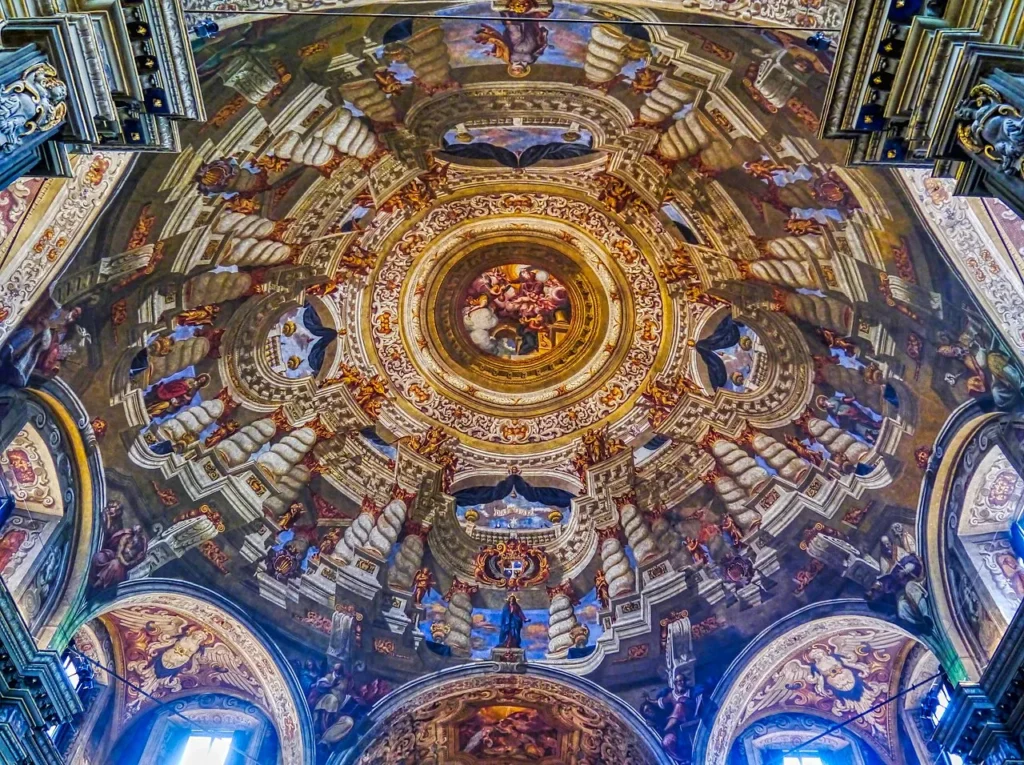
The dome, constructed in 1640 by Giovan Maria Bettera, stands as the most significant feature of the church. Designed by multiple architects and crafted with the expertise of skilled artisans, it has a large octagonal shape supported by eight arches that rest on four polylobed pillars and four pilasters at the entrance walls, both north and south. The dome occupies a substantial area within the church, measuring 22 meters across the transverse axis, 19.7 meters along the longitudinal axis, and reaching a height of 24.5 meters, all intricately decorated.
This construction replaced the original three naves, creating a unified space that extends from the barrel-vaulted entrance to the presbytery. While this design diverged from the traditional Latin cross layout favored by Saint Charles Borromeo during his pastoral visit in 1575, it succeeded in achieving the “persuasive splendor” sought after the Council of Trent.
Frescoed in 1681 by Giovan Battista Lambranzi, the vault features an illusionistic decoration that enhances the dome’s depth. The four supporting pillars depict the four evangelists, while the other supports showcase the four doctors of the Church. The architectural form symbolizes perfection, embodying a round shape within a square—an homage to the heavenly Jerusalem envisioned in the Apocalypse of St. John. Near the presbytery, the coat of arms of the Giovanelli family, an influential family from Gandino, is prominently displayed.
At the apex of the dome, the Annunciation is depicted, while the entrance features a medallion illustrating the angel’s announcement to St. Joseph. On the opposite side, near the presbytery, scenes of the Birth of Jesus and the Annunciation to the shepherds are represented. Above the presbytery, Ottaviano Vivarini’s fresco of the Holy Trinity shows God the Father, Christ, and the dove of the Holy Spirit.
The dome’s decoration is further enhanced by large shelves supporting an elaborate architecture, adorned with depictions of the four Church Fathers: Saint Jerome with the lion, Saint Augustine with sacred books, Saint Ambrose catechizing, and Saint Gregory the Great with a tiara and a dove, symbolizing enlightenment. Additional virtues are also illustrated throughout.
Cult of the Dead
In Gandino, the cult of the dead is deeply ingrained, especially following the devastating plague of 1630. This solemnity reaches its peak on November 2nd and the second Sunday of Lent, during which the community observes a “triduum of the dead,” a vibrant tradition that has been celebrated in the Bergamo area since the 18th century.
The centerpiece of this cult is the elaborate “machine of the cult of the dead,” designed by Giovan Battista Caniana in the 1780s. Shaped like a spoke with a five-meter diameter, it consists of multiple circles adorned with large candle holders that support 116 candles. At its center rests the monstrance, a 17th-century gift from the Giovanelli family. During the feast, altar furnishings are draped in black vestments, and a central calafalco is placed alongside macabre figures at the church entrances.
The first spoke was commissioned from Donato Fantoni in 1777 for 958 lire, but it failed to meet the expectations of the faithful, leading to the commissioning of a new design by Caniana.
Gandino Basilica Museum
Adjacent to the basilica, the Gandino Basilica Museum showcases a wealth of art and sacred objects that reflect the history of the town’s main religious site. Inaugurated in 1929 and renovated in 1963, the museum is divided into three sections.
The first section focuses on the church’s liturgical aspects, featuring sacred vestments and ornaments that are true works of art. Notable items include 15th-century crosses by Matrenianus de Filippis, tapestries by Belgian artists Frans Guebels, Cornelio and Enrico Mattens, and paintings by renowned artists such as Luigi Benfatto (known as Alvise dal Friso), Pietro Mango, Niccolò Frangipane, Antonio Balestra, Sebastiano Ricci, Domenico Carpinoni, Pietro Urbani, Albino Canali, and Pietro Servalli.
The second section, opened in 1998, is dedicated to a collection of nativity scenes, housed in three rooms on the first floor and showcasing approximately 280 examples.
The third section focuses on textile archaeology, highlighting the historical significance of the textile industry in Gandino. This area of the museum sheds light on how this industry has contributed to the town’s prosperity over the centuries.
Feast Day
Feast Day : 15th August
The feast day of the Basilica of Santa Maria Assunta in Gandino, Italy, is celebrated on August 15th. This date corresponds to the Feast of the Assumption of Mary, which honors the belief that Mary, the mother of Jesus, was assumed body and soul into heaven. The basilica, dedicated to this event, often hosts special liturgies and festivities in observance of the feast.
Church Mass Timing
Monday : 8:00 AM
Tuesday : 8:00 AM
Wednesday : 8:00 AM
Thursday : 8:00 AM
Friday : 8:00 AM
Saturday : 8:00 AM , 6:00 PM
Sunday : 8:00 AM , 10:30 AM , 6:30 PM
Church Opening Time:
Monday : 7:30 am – 12:00 pm, 3:00 pm – 5:00 pm
Tuesday : 7:30 am – 12:00 pm, 3:00 pm – 5:00 pm
Wednesday : 7:30 am – 12:00 pm, 3:00 pm – 5:00 pm
Thursday : 7:30 am – 12:00 pm, 3:00 pm – 5:00 pm
Friday : 7:30 am – 12:00 pm, 3:00 pm – 5:00 pm
Saturday : 7:30 am – 12:00 pm, 3:00 pm – 5:00 pm
Sunday : 7:30 am – 12:00 pm, 3:00 pm – 5:00 pm
Contact Info
Address:
Piazza della Emancipazione, 1, 24024 Gandino BG, Italy.
Phone : +39035745425
Accommodations
Connectivities
Airway
Bergamo Airport to Basilica of Santa Maria Assunta, Gandino, Italy distance between 34 min (32.4 km) via SS671.
Railway
Bergamo Railway Station to Basilica of Santa Maria Assunta, Gandino, Italy distance between 31 min (24.8 km) via SS671.

